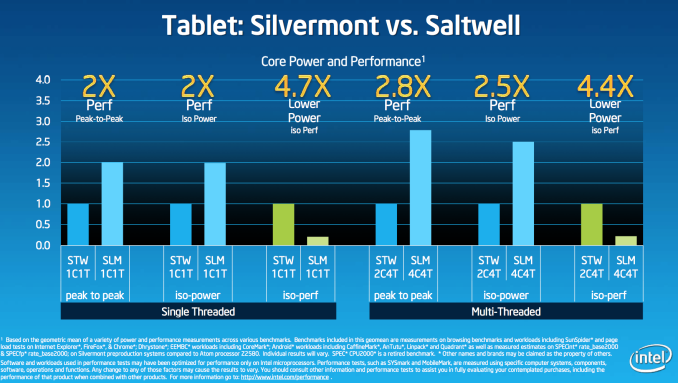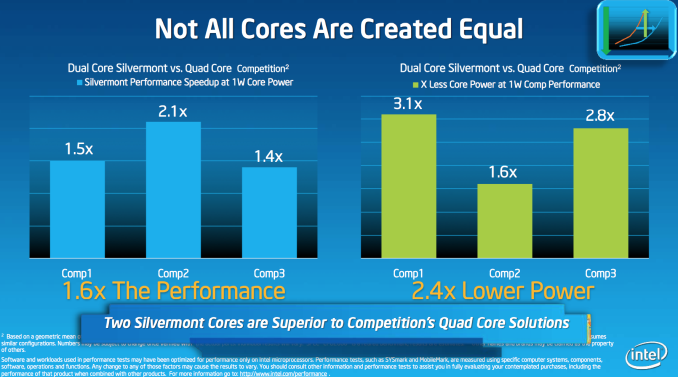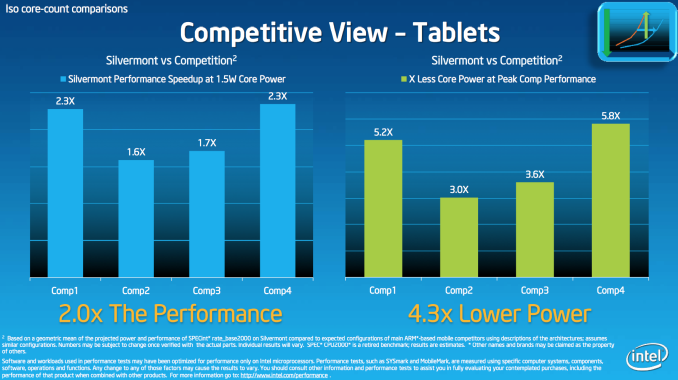Intel’s Silvermont Architecture Revealed: Getting Serious About Mobile
by Anand Lal Shimpi on May 6, 2013 1:00 PM EST- Posted in
- CPUs
- Intel
- Silvermont
- SoCs
Tablet Expectations
Intel is getting architectural details about Silvermont launch ahead of actual SoCs based on the CPU. Baytrail tablets based on Silvermont cores are currently in development and are expected to show up by the end of the year. The Silvermont story at the end of this year should be a lot better than Clovertrail last year. Windows 8 will be in its second major revision (codename Windows Blue) and Intel will launch with both Android and Windows tablet availability. The inclusion of Android is very important to hitting lower price points, something Clovertrail really didn’t have last year. We should see Baytrail based tablets span the gamut of Nexus 7 to iPad pricing, with Haswell picking up where Silvermont ends.
Form factors should be no thicker than Clovertrail based designs, although it will be possible to go thinner with Baytrail/Silvermont should an OEM decide to. Displays should also be a lot better this time around. Intel is working with some OEMs on color calibration, an important step forward as I’m hearing Qualcomm will be doing the same with Snapdragon 800. We’ll also finally see resolutions higher than 1366x768, including potentially some competition for the iPad with Retina Display. Silvermont’s new system agent should do a good job of prioritizing GPU access to main memory in these ultra high resolution scenarios.
Performance
With tablets still months away from being production ready, there’s nothing for us to publicly test. Intel did share some of its own numbers off of its Baytrail reference tablet however, and they are impressive.
All of the Intel comparisons report the geometric mean performance advantage over a spectrum of benchmarks. The benchmarks used include SPECint2K, CoreMark, SunSpider, web page load tests in IE/Chrome/Firefox, Linpack, AnTuTu and Quadrant (ugh) among others. The point here isn’t to demonstrate absolute peak performance in one benchmark, but to instead give us a general idea of the sorts of gains we should expect to see from Silvermont/Baytrail tablets vs the competition. It’s an admirable effort and honestly the right way to do things (short of actually giving us a pre-production tablet to test that is). We’ll start with a comparison to Saltwell, the previous-generation 32nm Atom core. The Saltwell results are listed as STW while Silvermont is abbreviated SLM:
In terms of absolute performance, Silvermont’s peak single threaded performance is 2x that of Saltwell. This 2x gain includes IPC and clock frequency gains (only 50% is from IPC, the rest is due to IDI, system agent and frequency). Given that Saltwell is competitive with existing architectures from ARM and Qualcomm (except for the Cortex A15), a 2x increase in single threaded performance should put Silvermont in a leadership position when it arrives later this year.
The next set of bars is just as important. At the same power levels (Intel didn’t disclose specifically at what power), Silvermont delivers 2x the performance of Saltwell. Finally, at the same performance level, Silvermont uses 4.7x lower power. Given that Saltwell wasn’t terrible on power to begin with, this is very impressive. Without knowing the specific power and performance levels however, I wouldn’t draw too many conclusions based on this data though.
The multithreaded advantages are obviously even greater as Silvermont will be featured in quad-core configurations while Saltwell topped out at dual-core (4 threads) in tablets.
In the next two slides, Intel did some competitive analysis with Silvermont vs. the ARM based competition. The benchmarks are the same, but now we have specifics about power usage. In the first test Intel is comparing to three competitors all with quad-core designs. Intel claims to have estimated performance gains based on what is expected to be in the market by the end of this year. Intel’s performance modeling group is very good at what it does, but as with any estimate you always have to exercise some caution in buying the data until we have physical hardware in hand.
Intel isn’t naming the three competitors in this chart, but there are only a finite number of quad-core ARM players shipping in decent tablet designs these days. The chart on the left compares performance of a dual-core Silvermont to quad-core ARM based designs at a 1W core power level. This comparison is extremely important because it’s effectively demonstrating the type of advantage Intel hopes to have in smartphones next year.
The chart on the right fixes performance and shows the reduction in core power. Do keep in mind that there can be a big difference between core and device level power, although Intel does expect to be very competitive on battery life this round.
The final performance comparison slide increases max core power to 1.5W and compares quad-core Silvermont to the quad-core competition. You’ll note the arrival of a new competitor here. One of the bars is a dual-core SoC with its performance scaled to four cores. I’m less confident about that particular estimation simply because it assumes Apple won’t significantly update architectures in its next generation of iPads.
The performance deltas here are huge. If we assume that at least one of these bars represents a Cortex A15 based design, Silvermont looks very good.
That’s the end of the Intel data, but I have some thoughts to add. First of all, based on what I’ve seen and heard from third parties working on Baytrail designs - the performance claims of being 2x the speed of Clovertrail are valid. Compared to the two Cortex A15 designs I’ve tested (Exynos 5250, dual-core A15 @ 1.7GHz and Exynos 5410 quad-core A15 @ 1.6GHz), quad-core Silvermont also comes out way ahead. Intel’s claims of a 60% performance advantage, at minimum, compared to the quad-core competition seems spot on based on the numbers I’ve seen. Power is the only area that I can’t validate based on what I’ve seen already (no one has given me a Baytrail tablet to measure power on). Given what we know about Silvermont’s architecture and the gains offered by Intel’s 22nm process, I do expect this core to do better on power than what we’ve seen thus far from ARM’s Cortex A15.
There is something we aren’t taking into account though. As of now, the only Cortex A15 based SoCs that we’ve seen have been very leaky designs optimized for high frequency. Should an SoC vendor choose to optimize for power consumption instead, we could see a narrower gap between the power consumption of Cortex A15 and Silvermont. Obviously you give up performance when you do that, so it may not ultimately change anything - but the power story might be less of a blowout.













174 Comments
View All Comments
Spunjji - Wednesday, May 8, 2013 - link
+1chubbypanda - Monday, May 6, 2013 - link
The article is about yet to be relased platform. Obviously you could get better information if you work for Intel or its OEM partners. If you don't, Anand's writing is as good as they get.Thrill92 - Tuesday, May 7, 2013 - link
But what's your point?raptorious - Monday, May 6, 2013 - link
It seems like every subsequent Anandtech article about Intel that I read sounds more and more like an Intel Marketing slide deck. I think I'd believe that the absolute performance of Silvermont is better than Cortex A15, but I'm very skeptical that the perf/watt will actually be better at the TDP that we care about for a tablet. I have a very hard time believing that a 2-wide OoO architecture will get better IPC than a 3-wide one. In order to achieve better performance, you'd have to very aggressively scale frequency, and as we all know, perf/watt usually decreases as you scale frequency up (C*V^2*F). It MIGHT be better perf/watt in a phone, simply because with a 2-wide architecture, you can scale dynamic power much lower, but of course, then you can't make the ridiculous claims of 1.6x performance.JarredWalton - Monday, May 6, 2013 - link
FWIW, Intel is willing to provide these detailed slide decks long in advance of the launch of their hardware. The other SoC vendors are far less willing to share information. If Apple, Qualcomm, or some other vendor put together a nice slide deck, I can guarantee we'd be writing about it.B - Monday, May 6, 2013 - link
@JarredWalton, I completely agree with your assessment. I have listened to every Anandtech Podcast and repeatedly hear Anand and Brian Klug lament the lack of transparency with the other SOC vendors. Those two go through great lengths to get any meaningful information on the roadmaps of Apple, Qualcomm, et al. The bottom line is that currently Intel is accustomed to sharing more information than its peers in the mobile industry and I suspect your readership wants to know what's coming long before the product is released, and this will always include a speculative component.beginner99 - Monday, May 6, 2013 - link
The intel slides basically say intel will have 8x better performance/watt. Now if you don't believe them, just half the numbers and you are at 4x, which is still huge...I believe it.Medfield uses a basically 5 year old design on an older process!!! than current ARM offerings and is competitive in performance/watt (it's actually better already). The only thing is how efficient the GPU will be and even more important how expensive the whole SOC will be. So even if the performance and power data is correct, not guarantee it will succeed.
I do see why some don't like the article but I think Anand is just enthusiastic and lets be honest, AMD has no delivered anything to be enthusiastic about in years and has a history of misinformation on slides What intel disclosed on slides was usually more or less true in the past so they have more credit than AMD.
raptorious - Monday, May 6, 2013 - link
Showing 8x perf/watt or even 4x perf/watt from generation to generation might be possible by milking numbers, but across the board that is laughably impossible. You're talking about defying the laws of physics. This architecture isn't radically different from A15 or other designs, and the process improvements of 22 nm over 32 nm don't just magically give you 4x perf/watt. If you want to live in Intel's fairy tale land, go ahead.JDG1980 - Monday, May 6, 2013 - link
Intel has far better fabs than anyone else. That alone gives them a huge advantage. The reason they've been doing so poorly up until now is that (as the article mentions) they've basically been stagnating with an Atom design dating back to 2004. Now that they've updated to a modern design, they should be able to beat their competitors decisively on the hardware side. Whether that will lead to design wins or not, who can say... they're pretty late to this particular game. But they can give it a good shot.t.s. - Tuesday, May 7, 2013 - link
Yeah, right. Same with AMD. After they 'upgrade' their architecture from star to bulldozer, they automagically have a huge advantage. Remember, changing architecture doesn't necessary a good thing. Moreover for the 1st time you do the change.